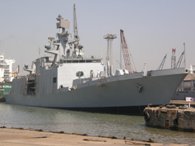 | « Back to article | Print this article |
India: Global hub for warship-building
 The INS Shivalik, now completing sea trials, is a world-class frigate built at Indian prices, writes Ajai Shukla.
The INS Shivalik, now completing sea trials, is a world-class frigate built at Indian prices, writes Ajai Shukla.
The Royal Navy had planned to build two Carrier Vessels Future (CVFs): the 65,000 tonne HMS Queen Elizabeth and HMS Prince of Wales.
With the budgeted price of US $6.4 billion (Rs 30,000 crore) for the pair, now apparently the cost of each, building a third and selling it abroad is an option being considered to reduce the unit price.
But, in contrast to this exorbitant price, the cost of India's 44,000 tonne Indigenous Aircraft Carrier (IAC), under construction at Cochin Shipyard Limited (CSL), is barely a third of the Queen Elizabeth.
And the Indian Navy's next IAC, a 60,000 tonne behemoth like the Queen Elizabeth, will cost less than half its British counterpart.
In the gloomy framework of Indian defence production, warship-building has emerged as a silver lining.
The Kolkata class destroyers, being built at Mazagon Dock Ltd, Mumbai, will cost the navy Rs 3,800 crore (Rs 38 billion) each, one-third the global price for comparative warships.
The INS Shivalik, now completing sea trials, is a world-class frigate built at Indian prices. Earlier this year, addressing an industries body, the Indian Navy's chief designer, Rear Admiral MK Badhwar, called for making India a global hub for building warships.
While his appeal might have been tinged with strategic motivation - a larger warship industry would bring down unit prices, providing the navy with even more bang for the buck - there is little doubt that shipbuilders would profit more from crafting warships than from slapping together merchant vessels.
India has developed the capabilities, including, crucially, the design expertise, to produce world-class warships. But the defence shipyards do not have the capacity to meet even the Indian Navy's needs; playing the international warship market needs clear-sighted government intervention to synergise the working of public and private shipbuilders.
Building a merchant ship is a relatively cheap and simple process, from design to outfitting. Essentially, it involves welding together a hull (often from imported steel) and then installing imported systems such as engines, radars, the steering, navigation and communications systems, and some specialist systems, e.g. for cargo handling.
Imported components form the bulk of the cost, with little value addition within the shipyard. A commercial shipyard's business plan revolves around bulk manufacture, compensating for the small profit margins by churning out as many ships as possible.
Creating a warship is infinitely more complex, and expensive. The design process is critical, with complex software shaping the "stealthiest" possible ship, virtually undetectable to an enemy. Next, a host of sensors and weapons must be accommodated to deal with different threats: enemy ships, submarines, aircraft and incoming missiles.
Harmonising their different frequencies, and canalising information and weapons control into a single command centre, involves weaving an elaborate electronic tapestry.Actually building the warship is a labour-intensive task, which involves painstakingly duplicating key systems so that the vessel can sail and fight even with one side blown out by the enemy. More than 400 kilometres of wiring must be laid out inside, all of it marked and accessible to permit repair and maintenance. A modern frigate has 25 kilometres of pipelines, built from 10,000 separate pieces of piping.
All this generates many jobs. An army of skilled craftsmen, many more than in merchant shipbuilding, does most of this work manually, through an elaborate eco-system of 100-200 private firms feeding into each warship.
And these numbers are growing as defence shipyards increasingly outsource, using their own employees only for core activities like hull fabrication; fitting propulsion equipment; and installing weapon systems and sensors.
In this manpower-intensive field, India enjoys obvious advantages over the European warship builders that rule the market. These advantages are far less pronounced in merchant shipbuilding, where Korean and Chinese shipyards are turbocharged by a combination of inexpensive labour, indirect subsidies, and unflinching government support.
What makes India a potential powerhouse in warship-building is not so much its labour-cost advantage as a strong design capability that the navy has carefully nurtured since 1954, when the Directorate General of Naval Design first took shape.
The importance of design capability has been amply illustrated in the bloated CVF programme. The UK, having wound up its naval design bureau, has already paid over a billion dollars to private companies to design the aircraft carrier.
And with every minor redesign, not unusual while building a new warship, the design bill and the programme cost goes higher.
India has everything it takes to be a warship-building superpower: the springboard of design expertise; cheap and skilled labour; and mounting experience in building successful warships.
What it lacks is capacity, which the government can augment with the help of private shipyards. This will significantly augment private shipyard revenue, boost defence exports, and provide the government with another strategic tool for furthering its interests in the Indian Ocean region.
